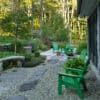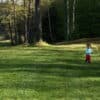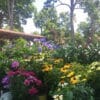An inside look at the industrious beavers living in my own backyard as they work to create their unique habitat of home.

The beaver lodge in an overgrown state. Photo: Steve Jonas.
I’ve become a huge fan of beavers. Our house looks down across a sloping meadow and a man-made swimming pond to a beaver lodge that sits directly in our view. It’s as though the beavers and we can both keep an eye on each other’s dwellings, while enjoying the use of our common landscape—our mutual habitat of home.

L: The beavers’ view; R: A busy beaver hard at work. Photos: L: Steve Jonas; R: Michael S. Quinton for National Geographic.
The Encarta dictionary defines a habitat as “the natural conditions and environment in which a plant or animal lives.” I’ve learned from the beavers that it’s not enough just to live on a landscape—you need to thrive there. When beavers are thriving, they’re constantly at work, eating leaves, twigs, roots, or aquatic plants or storing branches as a winter food source; but mostly patching their dams. I’ve read that the sound of trickling water drives them crazy, so they’ll work collaboratively—one beaver handing a stick to another—to keep their habitat safe. And now, with a layer of ice on the pond and snow across the winter landscape, the beaver couple is still busy, swimming under the ice through underground tunnels to nurture their kits and yearlings in a mud-packed cave under the lodge.

Winter comes to the beaver pond. Photo: Steve Jonas.
In the six years we’ve lived here, we’ve watched the beaver family come and go. Their elaborate lodge is not enough to keep them on the premises since the highly invasive buckthorn (Rhamnus cathartica—the perfect name!) has started overtaking the wetlands around them. This large shrub/small tree shades out developing native saplings that beavers use as a source for food and building materials. With no natural controls to curb its growth and black berries that act as a purgative for the birds that eat and distribute them, *uckthorn (as it’s known in our family) is quickly taking over ours—and the beaver’s land. Just last week, we saw that the beavers had repaired a dam with fresh buckthorn saplings—a hopeful sign that perhaps this dreaded invasive might yet prove useful to these resourceful creatures.

L: The approach to the beaver dam; R: Beaver waterways at Julie & Steve’s. Photos: Steve Jonas.
We can learn something from the beavers: It’s not enough to have a great “lodge” to live in; your landscape should meet your needs for sustenance, work, and play as well. In 2010, let’s continue to inspire, celebrate, and create habitats of home, both inside and out, where together we and other species can thrive.






You go girl!